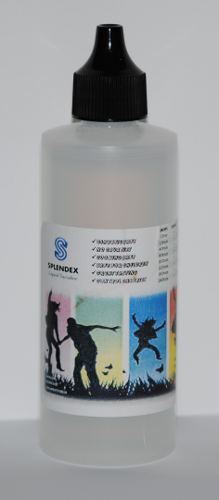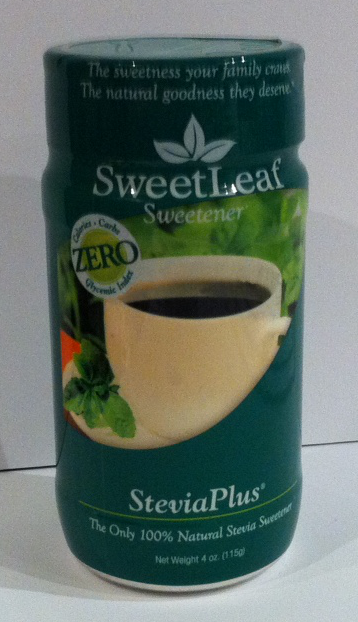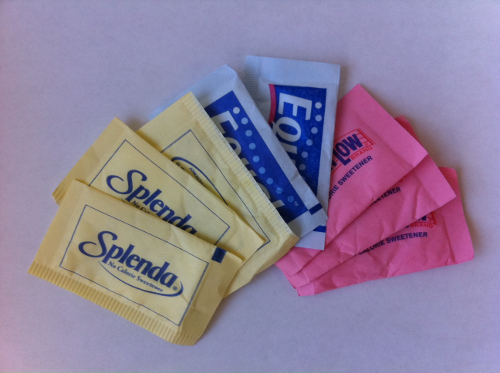I CAN Believe It’s Not Sugar

Liquid Sucralose
It’s probably a bit dramatic to say I pray everyday for my low carb desserts to taste like real desserts with real sugar, but that’s the general gist of how I feel. I’m filled with hope every time I smell those sweet aromas drifting out of my oven, and yet every time, I find that hope replaced with disappointment when I taste the dessert. I should really have realized long ago that artificial sugar will never taste like real sugar. Just try Coke Zero – no matter how much Coke advertises to the contrary, I can still taste that it’s just not real Coke! It’s as if mother nature made sure we would be punished for our gluttony. Is there any trace of hope then? Are low carb dieters doomed to consume only the first two courses of any prix fixe menu?
“artificial sugar will never taste like real sugar”
Well, not every dessert was an utter disaster. I think we have to live with the fact that it’s never going to be quite as good, but it can be close! I’ve been trying out pure liquid sucralose, which I bought from a very legit and US-based seller on Ebay, and I think it works ok in some desserts. So, the trick I’ve found is to make sure there’s something with a strong taste in your dessert that will cover up the fake sugar taste of the artificial sweetener. For example, I recently made a low-carb cheese cake. This turned out surprisingly well (especially considering I hardly ever bake and had never made cheesecake prior to that occasion!). The cheesecake recipe called for some lemon and vanilla, which covered up the sucralose taste quite well. I could still detect that it wasn’t real sugar – but if you don’t try to think too much, you could be mistaken… Cinnamon is another good masking agent. I made some sweet cinnamon crackers with liquid sucralose and flaxseed meal, which also turned out well.
“make sure there’s something with a strong taste in your dessert that will cover up the fake sugar taste of the artificial sweetener”
So what were the disasters? Chocolate. Chocolate and artificial sweeteners simply do not mix well together. Dark chocolate is naturally bitter, and you want the sweetener to balance out that bitterness, but all you end up tasting is a bitter taste with a sickly sweet twinge that makes you crumple your face in disgust. I even tried to make bacon truffles in the hope that the salty bacon taste would cover up some of that bitterness and drown out the fake sugar taste. I was wrong – even the coconut milk i tried adding to the concoction to mellow out the taste couldn’t save it. It was a treat fit only for the trash. I guess chocolate companies must have carried out those same cooking experiments, made the same crumpled faces, and thrown out the same batches of delicious looking but disgusting tasting chocolate. They then turned to alcohol sugars and made decent tasting chocolates, which aren’t good for you! What to do? I don’t have an amazing solution for this one, but I will keep wasting bars of perfectly good chocolate in my search! Here are a few options if you’re a chocolate-craving low carb dieter: 1) get used to eating really dark 85% chocolate, 2) treat yourself to a little bit of 75% or even 70% once in a while, or 3) try mixing a bit of alcohol, e.g. whiskey, and a tiny bit of sucralose into the melted chocolate to make alcoholic truffles (alcohol is the only thing I’ve found so far to cover up the sucralose taste sufficiently, but you have to really like the taste of alcohol!).
Next step: trying to see if adding a small amount of honey with liquid sucralose will create better tasting desserts.
July 4th – Low Carb Day
What better way to celebrate Fourth of July, US Independence Day, than to have a low carb dinner! I know a BBQ is the traditional feast for the celebration, but I plead ignorance (I’m from the country Americans are celebrating independence from, and to top it all, I have no balcony to grill on!). So, how to make a low carb dinner for 12? Simple – you just need a Costco card and a 3 day weekend to cook everything. The menu is just below, and recipes for all of the dishes are either already posted or will be posted in the near future. Pictures of the food are scarce because I was too busy stuffing myself (I’m just following the American tradition!).
Appetizers: 1) bacon-wrapped blue cheese-stuffed dates, 2) cauliflower and leek soup, 3) apple and gouda sausages, and 4) assorted nuts.
Main course: 1) roast beef (slow cooker style), 2) pork belly (pan seared and then cooked in slower cooker), and 3) faux white rice and faux fried rice.
Sides: 1) green beans (stewed and drained), 2) white radishes (stewed and drained), and 3) sauteed spinach.
Dessert: 1) New York cheesecake, 2) strawberries and sugar-free whipped cream, 3) assorted cookies, 4) whiskey chocolate truffles, and 5) assorted cheese with flaxseed crackers.
The cheesecake was definitely my favorite, but everyone seemed to really enjoy the faux rice! Recipes to follow shortly (especially for all the delicious desserts)… In the meantime, enjoy the fireworks.
Is the Stevia Sweetener the New Sugar?
You know how I said I’d try liquid Splenda? Well, I am going to, but I tried the Stevia sweetener first (mostly because their website told me where I can buy it in Manhattan). Although Stevia sounds like someone’s name (maybe an Aussie female version of Steve *see explanation below for joke), it’s actually a natural, 0 calorie, and 0 carb sweetener! Like liquid Splenda, the Stevia sweetener exhibits none of the bad insulin responses that can cause illnesses or obesity (studies so far are very positive about the Stevia sweetener, although the studies are inconclusive, like most studies in this area). However, unlike Splenda, which is made by chemically altering sugar, Stevia is natural (extracted from stevia plants). Of course, natural doesn’t always equate to good – after all, many poisons are also very natural! But, Stevia has been used with no ill effects in Japan for the past 40 years – that’s something, right? The other positives are that it comes in both liquid and powdered forms and reviews claim it has no bitterness or weird aftertaste.
The Verdict?
Taste: it tastes sweet, but definitely not like sugar. I’ve tried it in hot chocolate and tea, and it’s just not the same. When you put the pure substance on your tongue, it definitely stimulates a huge sweet taste, but it still tastes like an artificial sweetener. When I tried making hot chocolate using melted Baker’s chocolate, hot coconut milk, and Stevia, it ended up tasting like the Swiss Miss Diet Hot Chocolate i.e., low in calories but also low in taste! That said, both the hot chocolate and the tea (made with PG Tips, coconut milk, and Stevia – see photo) were drinkable!
Smell: (Aside: I really don’t go around sniffing white powders). This one doesn’t smell like much as a powder, but when you add it to some warm water, there’s a really strong cooked prune smell (don’t ask me how I know what a cooked prune smells like!).
In desserts: This is the category that I care the most about – does it make better tasting desserts? I’ve tried multiple times to add Stevia sweetener into my chocolate almond praline recipe with no success. Instead of alleviating the bitterness of the chocolate, it accentuates it and leaves a long-lasting fake sugar aftertaste in my mouth (not pleasant!). I’ve tried adding it in various amounts – 1/4 of a teaspoon is too little to notice, and 3/4 of a teaspoon is way way way too much (shudderingly disgusting)! I thought 1/2 a teaspoon would be just the right amount, but it still did not taste right. I tried adding in cream, coconut milk, and coconut oil all to no avail.
Conclusion: Although it’s passable in a hot drink, it does not seem to do too well when it comes to desserts. And since desserts are what I crave, I’m going to have give Stevia the thumbs down! And so the search for the perfect sweetener continues…
*Aussies love shortening their words and adding an “ee” sound to the end of it…think brekkie (breakfast), Tassie (Tasmanian devil), and Aussie (Australian). So in Australian English, Steve would become Stevie and Stevia would be the female version of the name. Ok, this joke has lost all of its humor in this explanation. Just smile and move on!
The Healthy Alcoholic
A drink anyone? I love wine, and I love cocktails, and most of all, I love Pimms and lemonade (it’s a British thing, best enjoyed while lazing in a boat being rowed by someone else). Like most professionals in this city, alcohol seems to be a necessary part of every friday evening (well, and saturday evenings, and various other evenings, but shhhhh). But the carb content in wines and cocktails is so high that being on the diet was seriously disturbing my weekend activities, not to mention my wine blog! So what can I drink on a low carb diet? Pretty much all diets tell you to not drink any alcohol, but those are pretty hard diets to stick with! Luckily, there are alcohols that are low in carb and even carbless!
Wines: Wine calories are pretty high (and since wine pretty much always has some residual sugar, they have carbs). A dessert wine or a sweet riesling is high in calories and in carbs (approx. 150 calories and 16g of carbs for a 4oz serving). That definitely makes me think twice about opening all those bottles of riesling clogging up my fridge! But a 4oz glass (a stingy pouring) of red or white wine has around 100 calories and 2-3g of carbs. So a small glass is maybe doable a few times a week.
Champagne: If you’re just looking to hold a pretty glass and look like you’re drinking, then champagne or one of the other bubbly alternatives (e.g. brut or prosecco) is the way to go! A glass of bubbly has 85 calories and 1.2g of carbs (for a 4oz serving). But what do you expect? You are after all mostly ingesting air!
Beer: I guess the beer belly thing sort of gives this one away. A bottle of Bud Light has 110 calories and 6.58g of carbs. A regular Bud is 146 calories and 10.6g of carbs. I think this is definitely the avoid at all cost option (along with all cocktails).
And the winner is…HARD LIQUOR! Who would have thought that all those shots you drank last night was actually healthy! Distilled alcohols like gin, rum, whiskey, and vodka are all carbless. Yep, a shot of any of them contains 97 calories and 0 carbs. And who says you can’t have fun on a diet! The reason why there are no carbs is because it’s pure alcohol, which is not technically considered carbs.
Caveat: some sources say even pure alcohol can cause an insulin response, which is why diets discourage you from drinking any of that stuff. But let’s just pretend I didn’t read about that part for a while. 🙂
A Sweet Lunch With Sweeteners
It’s amazing what you can learn over lunch! As I sat at Gordon Ramsey’s Maze restaurant in New York for lunch last week, our table’s conversation turned to artificial sweeteners and their effect on low-carb diets. (This was while I chomped on my carb free rib eye steak!) I had been under the impression that artificial sweeteners were bad in the same way that sugars were bad. I had recently researched into malitol (read my low carb chocolate post for more on malitol), which is a sugar alcohol frequently used in low-carb or sugar-free chocolates, and had found malitol to be poor sugar substitute for those on a low-carb diet. I had unfortunately jumped to the conclusion that basically anything sweet-tasting would be just as bad!
As I propounded my “all sweet tasting substitutes are awful for a low-carb diet” theory, one person at lunch corrected me by explaining that Splenda is actually not digested by our body and therefore would probably not cause the same insulin responses as normal sugar. This sounded wonderful, and I hopped onto the internet as soon as I could after lunch to discover the truths behind artificial sweeteners!
I remained very skeptical during my perusing of internet sites until I read Mark Sisson’s post on artificial sweeteners. Having been a physicist in an earlier life, scientific studies sway me way more than even the opinions of well-established nutritionist. The general scientific consensus definitely seems to be that Splenda does not produce spikes in your blood sugar (see my post on blood sugar levels versus insulin levels to understand this concept a bit better), but there are still some problems, which luckily can be overcome:
- If you consume Splenda on an empty stomach, your body may still produce insulin even though Splenda is not absorbed into your bloodstream. How does that happen? As soon as you put anything that tastes like sugar into your mouth, the taste buds on your tongue tells your body to start producing insulin immediately in anticipation of the rise in your blood sugar levels. Evolutionarily-speaking, this mechanism is great, because it allows your body to quickly respond to increases in your blood sugar level to prevent too much of a spike, which can be very dangerous (hence why diabetics who produce no insulin to regulate their blood sugar levels would die if they didn’t take insulin before eating dessert!).
- Most Splenda you find sold in supermarkets or at available at your coffee shop is mixed with a bulking agent (commonly dextrose), which does produce an insulin response in your body. Therefore, it’s best to use pure Splenda, which you can purchase online in a liquid form.
So bottom line? You can use pure Splenda (not the white powdery stuff you get usually) on a low carb diet if you consume the food that contains Splenda with a low-carb meal. Well, that’s pretty positive right? It certainly sounds like some more experimentation in my kitchen!








